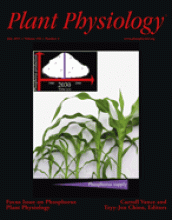Ver ítem
- xmlui.general.dspace_homeCentros e Institutos de InvestigaciónCICVyA. Centro de Investigación en Ciencias Veterinarias y AgronómicasInstituto de BiotecnologíaArtículos científicosxmlui.ArtifactBrowser.ItemViewer.trail
- Inicio
- Centros e Institutos de Investigación
- CICVyA. Centro de Investigación en Ciencias Veterinarias y Agronómicas
- Instituto de Biotecnología
- Artículos científicos
- Ver ítem
Coupling virus-induced gene silencing to exogenous green fluorescence protein expression provides a highly efficient system for functional genomics in arabidopsis and across all stages of tomato fruit development
Resumen
Since the advent of the postgenomic era, efforts have focused on the development of rapid strategies for annotating plant genes of unknown function. Given its simplicity and rapidity, virus-induced gene silencing (VIGS) has become one of the preeminent
approaches for functional analyses. However, several problems remain intrinsic to the use of such a strategy in the study of both metabolic and developmental processes. The most prominent of these is the
[ver mas...]
Since the advent of the postgenomic era, efforts have focused on the development of rapid strategies for annotating plant genes of unknown function. Given its simplicity and rapidity, virus-induced gene silencing (VIGS) has become one of the preeminent
approaches for functional analyses. However, several problems remain intrinsic to the use of such a strategy in the study of both metabolic and developmental processes. The most prominent of these is the commonly observed phenomenon of
“sectoring” the tissue regions that are not effectively targeted by VIGS. To better discriminate these sectors, an effective marker system displaying minimal secondary effects is a prerequisite. Utilizing a VIGS system based on the tobacco rattle virus vector, we here studied the effect of silencing the endogenous phytoene desaturase gene (pds) and the expression and subsequent silencing of the exogenous green fluorescence protein (gfp) on the metabolism of Arabidopsis (Arabidopsis thaliana) leaves and tomato (Solanum lycopersicum) fruits. In leaves, we observed dramatic effects on primary carbon and pigment metabolism associated with the photobleached phenotype following the silencing of the endogenous pds gene. However, relatively few
pleiotropic effects on carbon metabolism were observed in tomato fruits when pds expression was inhibited. VIGS coupled to gfp constitutive expression revealed no significant metabolic alterations after triggering of silencing in Arabidopsis leaves and a
mild effect in mature green tomato fruits. By contrast, a wider impact on metabolism was observed in ripe fruits. Silencing experiments with an endogenous target gene of interest clearly demonstrated the feasibility of cosilencing in this system; however, carefully constructed control experiments are a prerequisite to prevent erroneous interpretation.
[Cerrar]

Autor
Quadrana, Leandro Daniel;
Rodriguez, Maria Cecilia;
Bermudez Salazar, Luisa;
Nunes Nesi, Adriano;
Fernie, Alisdair R.;
Descalzo, Adriana Maria;
Asis, Ramón;
Rossi, Magdalena;
Asurmendi, Sebastian;
Carrari, Fernando;
Fuente
Plant physiology 156 (3) : 1278–1291. (July 2011)
Fecha
2011-07
ISSN
1532-2548
Formato
pdf
Tipo de documento
artículo
Palabras Claves
Derechos de acceso
Abierto
 Excepto donde se diga explicitamente, este item se publica bajo la siguiente descripción: Creative Commons Attribution-NonCommercial-ShareAlike 2.5 Unported (CC BY-NC-SA 2.5)
Excepto donde se diga explicitamente, este item se publica bajo la siguiente descripción: Creative Commons Attribution-NonCommercial-ShareAlike 2.5 Unported (CC BY-NC-SA 2.5)


